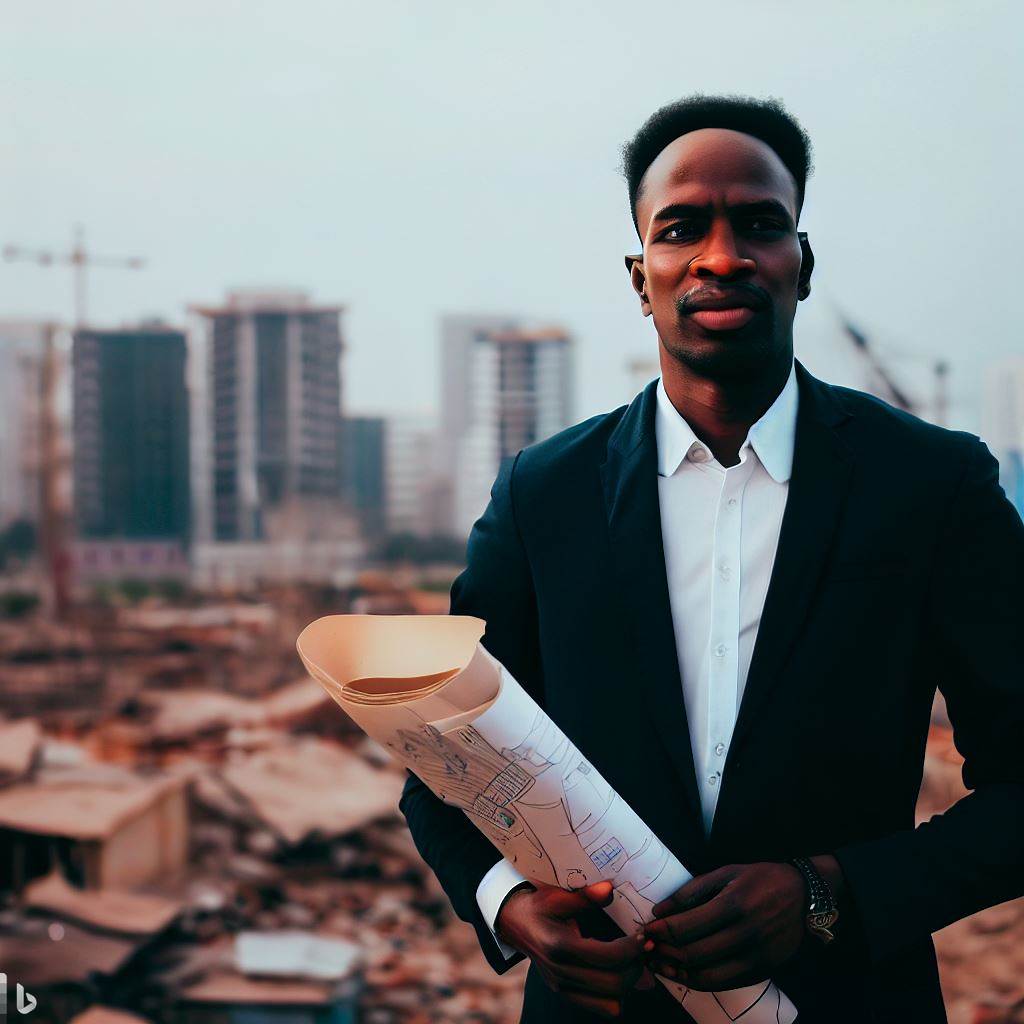Introduction
Community development refers to the process of improving the social, economic, and environmental conditions of a specific group of people or a locality.
This process is essential in ensuring sustainable growth, improving the quality of life, and promoting social harmony.
Architects play a critical role in community development by designing and constructing functional buildings and public spaces that cater to the needs of the community.
In Nigeria, architects work closely with other professionals such as engineers and town planners to develop communities that are resilient to social, economic, and environmental challenges.
Nigerian architects have a significant impact on community development. They bring innovative ideas and solutions to the table, considering local resources, traditions, and cultures.
Their works reflect a balance between modernity and culture and foster community development by promoting social interaction and inclusiveness.
Moreover, Nigerian architects are key players in the development of sustainable communities that promote environmental conservation, efficient resource utilization, and emission reduction. Their designs incorporate green building practices, renewable energy technologies, and low-cost locally sourced building materials.
Given the importance of community development in Nigerian society, architects have a crucial role to play to ensure the growth and sustainable development of local communities.
Nigerian architects can leverage their expertise to shape policies and promote community-oriented development strategies aimed at creating a better future for all Nigerians.
Read: Appreciating Nigeria’s Architectural Heritage and Conservation
History of Nigerian Architecture
Architecture in Nigeria has a rich history that dates back to the pre-colonial era. Nigerian architecture has evolved over time, influenced by the country’s diverse culture and traditions.
The use of locally available materials, such as mud, wood, and thatch, characterized the early forms of buildings in Nigeria.
The colonial era saw the introduction of modern architecture in Nigeria. European architects were involved in the design and construction of public buildings such as schools, hospitals, and government offices.
However, after independence, Nigerian architects began to emerge, contributing to the development of architecture in the country.
One of the notable Nigerian architects is Demas Nwoko, who designed and constructed the famous Nsukka Art School. His work is unique and has been described as a fusion of traditional African architecture with modern techniques.
Another prominent Nigerian architect is Rotimi Fani-Kayode, who was renowned for his innovative designs that incorporated traditional Nigerian elements. His contribution to Nigerian architecture has been immeasurable.
Nigerian architecture has had a significant influence on contemporary architecture in the country
The use of locally available materials and traditional design elements have been incorporated into modern designs.
Architects in Nigeria continue to explore innovative ways of using local materials to create sustainable buildings that reflect the country’s cultural diversity.
For example, the Nigerian Institute of Architects has been at the forefront of promoting environmentally sustainable architecture, and they have organized several workshops and conferences to sensitize architects on sustainable building practices.
This has led to the popularization of the use of eco-friendly materials such as bamboo, adobe, and rammed earth in the construction of buildings.
In fact, Nigerian architecture has come a long way, from the use of mud huts to modern designs that incorporate traditional elements.
The contributions of Nigerian architects have been significant in the development of architecture in the country.
The use of local materials and traditional design elements has influenced contemporary architecture in Nigeria.
Architects in Nigeria continue to explore innovative ways of creating sustainable and environmentally friendly buildings that reflect the country’s cultural diversity.
Read: Addressing Housing Crisis through Architecture in Nigeria
The Importance of Community Development
Community development plays a significant role in the economic and social growth of a society. It focuses on improving the quality of life of individuals, communities, and the overall country.
In Nigeria, community development has a rich history and is essential in achieving sustainable development goals.
Architects play a crucial role in this development, and their contribution cannot be overlooked.
Let’s discuss the effects of community development on the economy and society, the historical significance of community development in Nigeria, and how architecture contributes to community development in Nigeria.
Effects of Community Development on the Economy and Society
Community development has a direct impact on the economy and society. It creates an enabling environment that fosters social interactions, increases productivity, and stimulates economic growth.
A well-developed community provides access to basic social amenities such as healthcare, education, and affordable housing, which in turn enhances human capital development, employment opportunities, and reduces poverty levels.
Community development also enhances social cohesion, promotes cultural diversity, and creates a sense of belonging and identity.
Additionally, it creates opportunities for community members to participate in decision-making processes that affect their lives, promoting democracy and good governance.
Historical Significance of Community Development in Nigeria
In Nigeria, community development has been a significant area of focus since the colonial era. The colonial government introduced community development projects to promote unity, improve infrastructure, and provide social services to communities.
During the post-colonial era, community development played a vital role in Nigeria’s development agenda. The first national development plan (1962-1968) had a strong emphasis on community development.
The government’s policies during this period aimed at empowering communities to take charge of their development and participate in the decision-making processes. Today, community development continues to be a crucial aspect of Nigeria’s development agenda.
How Architecture Contributes to Community Development in Nigeria
Architecture plays a critical role in community development in Nigeria. Architects are responsible for creating functional and innovative designs that reflect the needs and aspirations of the community.
They work with community members, government agencies, and other stakeholders to design structures that promote social, economic, and environmental sustainability.
Architecture provides solutions to social issues such as inadequate housing, lack of social amenities, and environmental degradation. Architects design structures that promote energy efficiency, natural ventilation, and the use of environmentally friendly materials.
Additionally, architects create designs that promote accessibility, safety, and comfort for community members, especially those with disabilities.
In essence, community development plays a crucial role in the economic and social growth of Nigeria.
The historical significance of community development in Nigeria underscores the importance of community development in achieving sustainable development goals.
Architects play an essential role in community development by designing structures that reflect the needs and aspirations of the community.
The role of Nigerian architects in community development is vital in achieving sustainable development in Nigeria.

Delve into the Subject: Leveraging Tech in Nigeria’s Architecture Profession
Uncover the Details: Role of Women in Nigeria’s Thriving Architecture Scene
The Role of Nigerian Architects in Community Development
Types of community development projects
Nigerian architects are involved in various community development projects such as the building of houses for the less privileged, creation of public spaces, construction of schools and hospitals, and renovation of historic sites.
Ways in which architects enhance community development
Architects bring their knowledge and skills to community development projects as they design buildings that are functional, safe, and aesthetically pleasing.
They also ensure that the projects are sustainable, environmentally friendly, and responsive to the needs of the community.
In addition, architects work with other professionals such as engineers, planners, and contractors to ensure that the entire project is well-planned, executed and completed within a specified time and budget.
Real-life examples
Nigerian architects have undertaken community projects with significant impacts. Kunle Adeyemi’s NLÉ Architects transformed the Central Mosque in Lagos, accommodating the growing Muslim community.
Esenowo Akan designed the Arewa House complex in Kaduna, housing a museum, conference center, library, and research facility.
The Onikan Youth Centre in Lagos, designed by Olaokun Soyinka, serves as a hub for community gatherings and events. It offers various spaces for sports, music, dance, and computer training, empowering young people and promoting social integration.
Nigerian architects contribute their knowledge and skills to community projects, improving lives, preserving cultural heritage, and promoting development.
Read: Dissecting The Architect Registration Council of Nigeria
Challenges Faced by Nigerian Architects in Community Development
Community development is an important aspect of national development, and Nigerian architects play a significant role in this process.
However, the architects face various challenges that hamper their efforts to contribute positively to community development.
This section outlines some of the challenges faced by Nigerian architects in community development, discusses their impact on community development projects, and highlights possible solutions to overcome these challenges.
Different Challenges Faced by Nigerian Architects in Community Development
- Limited Access to Funding: One of the primary challenges faced by Nigerian architects in community development is limited access to funding. Many architects struggle to raise the necessary funds to execute their projects, as they have to rely on government or private support.
- Poor Infrastructural Development: In Nigeria, inadequate infrastructural development poses a significant challenge for architects in community development. Architects have to contend with poor roads, lack of electricity, and other basic amenities that are essential for successful community development projects.
- Lack of Collaboration: Effective community development requires collaboration among different stakeholders, including architects, the government, and local communities. However, architects often face challenges in collaborating with these stakeholders towards achieving the common goal of community development.
- Difficult Regulatory Environment: The regulatory environment in Nigeria can be challenging, with various government regulations and bureaucratic processes. Architects sometimes struggle to navigate these regulations and secure the necessary approvals required for community development projects.
- Social and Cultural Barriers: Nigeria has a diverse culture, and architects have to contend with different socio-cultural beliefs and aspirations that can affect community development projects. Some communities may be resistant to change or fail to understand the benefits of community development.
Read: How Nigerian Architects are Reshaping Urban Landscapes
Impact of These Challenges on Community Development Projects
The challenges faced by Nigerian architects in community development have significant consequences on the success of community development projects.
Here are some ways the challenges affect community development projects:
- The lack of access to funding makes it challenging for architects to execute community development projects effectively, thereby limiting the impact of these projects on the community.
- Poor infrastructural development can hamper the ability of architects to carry out their projects, leading to substandard project execution.
- A lack of collaboration can result in a lack of community involvement and reduce successful project implementation.
- The regulatory environment can negatively affect community development projects, leading to delays or even project cancellation.
- Social and cultural barriers can hamper the success of community development projects as architects may struggle to win community acceptance or support.
Possible Solutions to Overcome These Challenges
Despite the challenges, Nigerian architects can overcome them and contribute positively to community development. Here are some possible solutions to overcome these challenges:
- Budget Optimization: Architects can optimize their budgets and reduce project costs by exploring alternative financing models, such as crowdfunding or partnerships with non-governmental organizations.
- Engaging Local Communities More: Architects should engage local communities more in their project planning and execution processes. This approach will help to build trust and understanding of the project objectives and enhance community support.
- Collaborating with the Government: Architects can work with the government to secure project approvals faster, as well as access to various funding opportunities that can support their community development projects.
- Improving Regulatory Compliance: Architects can improve their regulatory compliance by building relationships with government agencies and understanding the regulatory environment better.
- Sensitivity to Cultural Differences: Architects should be more sensitive to cultural differences by identifying and addressing potential socio-cultural barriers to community development projects.
In summary, Nigerian architects face various challenges in community development projects.
These challenges can be addressed through effective collaboration, optimized budgets, engaging local communities, working with the government, and improving regulatory compliance.
Addressing the challenges will ultimately enhance the impact of community development projects on Nigerian communities.
Conclusion
Nigerian architects contribute to their communities’ development by designing sustainable spaces for present and future needs.
Architects have the opportunity to inspire positive change and impact communities through their projects.
We encourage Nigerian architects to take up community development projects and positively impact their communities.
As architects, our responsibility is to create spaces that fulfill clients’ needs and benefit the wider community.




